Pre-Calculus 11 Student Edition Chapter 3 Quadratic Functions
Page 198 Problem 1 Answer
We have in the standard vertex form,
f(x)=(x+6)2−14.
Then we need to find the vertex, the axis of symmetry, the direction of opening, the maximum or minimum value, and the domain and range without graphing.
Compare y=(x+6)2−14 with y=a(x−p)2+q.
a=1,p=−6,q=−14
We observe that vertex is at (−6,−14) and axis of symmetry at x=−6.
And we have a=1>0 so the graph opens upward . Minimum value is -14 since the parabola opens upward
Domain of given parabola is (−∞,∞)& range is {y∣y≥−14,y∈R}.
The quadratic function has Vertex : (−6,−14). Axis of symmetry: x=−6.
Graph opens upwardMinimum value is −14.
Domain is (−∞,∞).Range is {y∣y≥−14,y∈R}.
Precalculus Textbook Mcgraw Hill Answers
Page 198 Problem 2 Answer
We have in the standard vertex form,f(x)=−2x2+19.
Then we need to find the vertex, the axis of symmetry, the direction of opening, the maximum or minimum value, and the domain and range without graphing.
Compare y=−2x2+19 with y=a(x−p)2+q.
a=−2,p=0,q=19
We observe that vertex is at (0,19) and axis of symmetry at x=0 .
And we have a=−2<0 so the graph opens downward.
Maximum value is 19 since the parabola opens downward.
Domain of given parabola is(−∞,∞) & range is {y∣y≤19,y∈R}.
The quadratic function has Vertex : (0,19) . Axis of symmetry:x=0
Graph opens downward.
Maximum value is 19.
Domain is(−∞,∞).
Range is{y∣y≤19,y∈R}.
Read and Learn More Precalculus Textbook Mcgraw Hill Answers
Page 198 Problem 3 Answer
We have in the standard vertex form,f(x)=1/5(x−10)2+100.
Then we need to find the vertex, the axis of symmetry, the direction of opening, the maximum or minimum value, and the domain and range without graphing.
Comparey=1/5(x−10)2+100 with y=a(x−p)2+q.
a=1/5,p=10,q=100
We observe that vertex is at(10,100) and axis of symmetry at x=10.
And we have a=1/2>0 so the graph opens upward . Minimum value is 100 since the parabola opens upward.
Domain of given parabola is(−∞,∞) & range is{y∣y≥100,y∈R}
Vertex :(10,100).Axis of symmetry:x=10 Graph opens upwards.Minimum value is 100.Domain is (−∞,∞) .Range is{y∣y≥100,y∈R}.
Page 198 Problem 4 Answer
We have in the standard vertex form,
y2=−6(x−4)2+0
We observe that vertex is at (4,0) and axis of symmetry at x=4
And we have a=−6<0, we have maxima at the point (4,0).
Since,maxima exists at the vertex, the parabola is an open down parabola.
Domain of y is (−∞,−∞), range is (−∞,0)
It is an open down parabola with vertex at (4, 0), Has axis of symmetry at x = 4 and maxima at x = 0and the maximum value is y = 0.
Precalculus Textbook Mcgraw Hill Answers
Page 198 Problem 5 Answer
We have the quadratic equation written in the standard vertex form:
f(x)=2(x+1)2−8
Therefore, we have a=2,p=−1,q=−8
We have the sketch of the graph:

We observe that the vertex exists at (−1,−8), with axis of symmetry on the line x=−1,
We see that the vertex is a point of minima. The domain of the graph is (−∞,∞) and range is [−8,∞)
Vertex is the minima, is at (−1,−8), we have domain as (−∞,∞) and range as [−8,∞)
Page 198 Problem 6 Answer
We have the quadratic equation given in the vertex form:
f(x)=−0.5(x−2)2+2
a=−0.5,p=2,q=2
We have sketch of the graph:
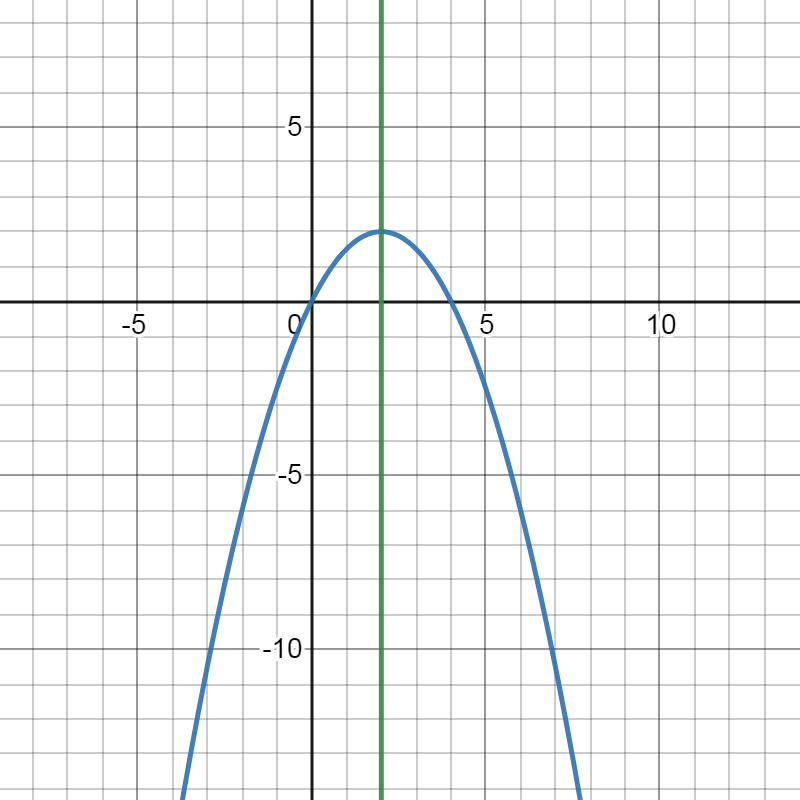
We observe that the vertex exists at (2,2) and the line x=2 is the axis of symmetry
Maxima exists at (2,2), the domain of the graph is (−∞,∞) rang is (−∞,2]
Vertex exists at (2,2), it is the point of maxima. Axis of symmetry is the line x=2.
Domain of the graph is (−∞,∞) range is (−∞,0]
Precalculus Textbook Mcgraw Hill Answers
Page 198 Problem 7 Answer
We have the equation : y=−3(x−5)2+20
Therefore a=−3,p=5,q=20
For x-intercepts we need
y=0=−3(x−5)2+20
⟹(x−5)2
=20/3 (x−5)=±√20/3
⟹x=±√20/3+5
For y-intercept we need x=0, therefore we have y=−3(−5)2+20⟹y=−55
Number of x-intercepts are two and there exists one y-intercept.
Page 198 Problem 8 Answer
We are given a parabola with domain and range conditions as follows:
Domain: (−∞,∞)
Range: [0,∞)
We need a parabola of the form
y=a(x−p)2+q with a>0 and q≥0
There exists one-intercept each at y and x-axes when q=0
There exists no x-intercept one y-intercept at (0,q) for q>0.
There exists one x and one y-intercept for q=0 at the origin. When q>0, we have only y-intercept at (0,q)
Page 198 Problem 9 Answer
We have the equation y=3x2+9
Therefore we have a=3,q=0,p=9,
We know that for q>0, there exists only one y-intercept at (0,q).
We have q=9>0, therefore the y-intercept of the parabola is at (0,9).
There exists no x-intercept.
There exists a y-intercept at (0,9), there is no x-intercept.
Mcgraw Hill Precalculus Textbook Answers
Page 198 Problem 10 Answer
Given a parabola with a vertex at(−4,−6)
We can determine the quadratic function in vertex form if know the coordinates of the vertex and at-least one other point.
We can determine the number of x-intercepts of a graph of a quadratic function using the value of a to determine if the graph opens upward or downward and the value of q to determine if the vertex is above, below, or on the x-axis.
But we have only coordinate of vertex so we can’t determine the quadratic function in vertex form and Also we can’t determine the number of x-intercepts of a graph of a quadratic function.
Because we don’t know the graph opens upward or downward.
We can’t determine the number of x-intercepts in a parabola with a vertex at(−4,−6)
Page 198 Problem 11 Answer
There is given a graph of a parabola.
It is asked to determine a quadratic function in vertex form.
The quadratic function can be found by finding the vertex and applying the vertex form of the parabola formula.
Firstly, we can find the vertex from the graph
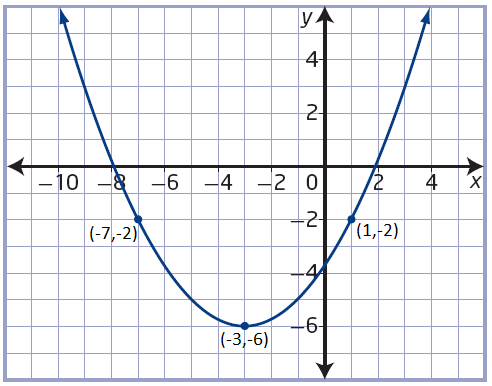
We know that vertex of any parabola is the point where the graph changes its shape.
The graph is changing shape at(−3,−6)
So, the vertex is(p,q)=(−3,−6)
Apply vertex form of the parabola formula:y=a(x−p)2+q
Plug vertex point into the formula
y=a(x+3)2−6 −−−−−(1)
Now, we can select anyone point and find a
The point is(1,−2)
Plug this point in equation (1) we get
−2=a(1+3)2−6
−2+6=a(4)2
4=16a
a=4/16
a=1/4
Plug this value into the formula (2) we get
y=1/4(x+3)2−6
which is required quadratic function.
The quadratic function in vertex form is y=1/4(x+3)2−6
Mcgraw Hill Precalculus Textbook Answers
Page 198 Problem 12 Answer
The given graph of the parabola is as following :-
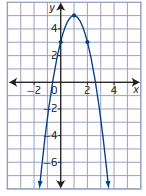
We have to find the quadratic function of the graph in vertex form.
Firstly we will find the vertex of the parabola from the graph and then use the vertex form formula for parabola.
From the above graph, we can see that the parabola changes its shape at point (1,5).
So the vertex of the parabola (p,q)=(1,5)
Apply the vertex form of parabola y=a(x−p)2+q, then we have :-
y=a(x−1)2+5.
Now consider a point of parabola . Let the point is (0,3). By putting this point in the above equation then we have :-
3=a(0−1)2+5
⇒3=a(−1)2+5
⇒3=a+5
⇒a=3−5
⇒a=−2
Put the value of a=−2, then we have :-
y=−2(x−1)2+5.
This is the required quadratic function of given graph in the vertex form.
The required quadratic form for the given graph in vertex form is y=−2(x−1)2+5.
Mcgraw Hill Precalculus Textbook Answers
Page 199 Problem 13 Answer
The cable of the bridge is a shape of a parabola.
The length of the complete bridge is 274m, the lowest point of the cable is 30m above the water surface, and the highest point of the bridge is 52m above the water surface.
The bridge looks like:

We know that, equation of a parabola with it’s vertices (p,q) is y=a(x−p)2+q.
We put the co-ordinate values of p and q to the quadratic to find the equation of the parabola at different locations of the origin.
(1) When the origin is at the minimum point of the cable:
The minimum point of the cable is the vertex of the parabola.
So, the graph of the parabola representing the curved cable will look like:

Therefore, the value of (p,q)=(0,0). Hence the equation of the parabola in this case will be
y=a(x−p)2+q
⇒y=a(x−0)2+0
⇒y=ax2
(2) a point on the water’s surface directly below the minimum point of the cables
The distance from the water surface to the minimum point of the parabola is 30m. Hence the graph of the parabola is as follows:
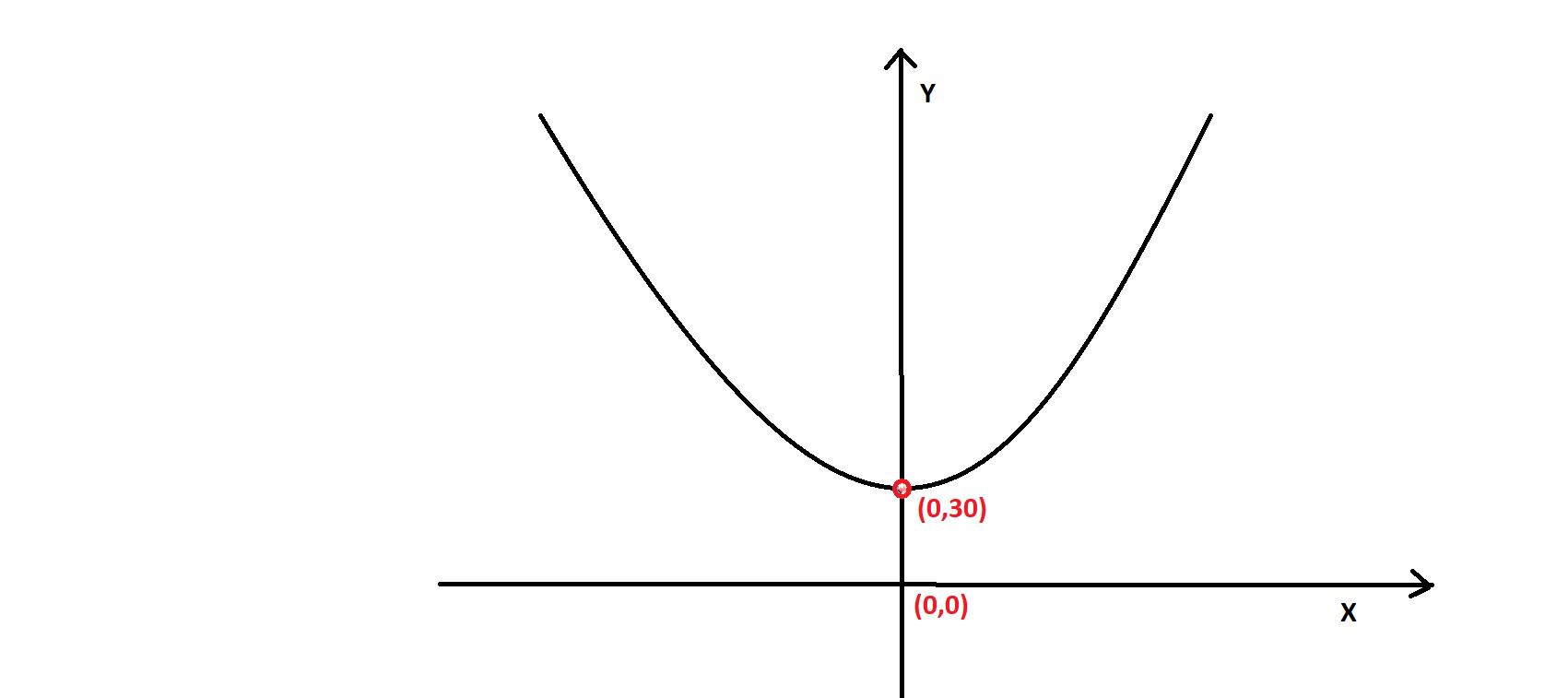
Hence, the vertex of the parabola is (0,30). So, (p,q)=(0,30).
The equation of the parabola will be
y=a(x−p)2+q
⇒y=a(x−0)2+30
⇒y=ax2+30
(3) When the origin is at the base of the tower on the left:
The horizontal distance of the vertex of the bridge from the base of the tower on the left is half the length of the bridge, i.e. 274/2=137m and the vertical distance is 30m.
So the graph will look like:
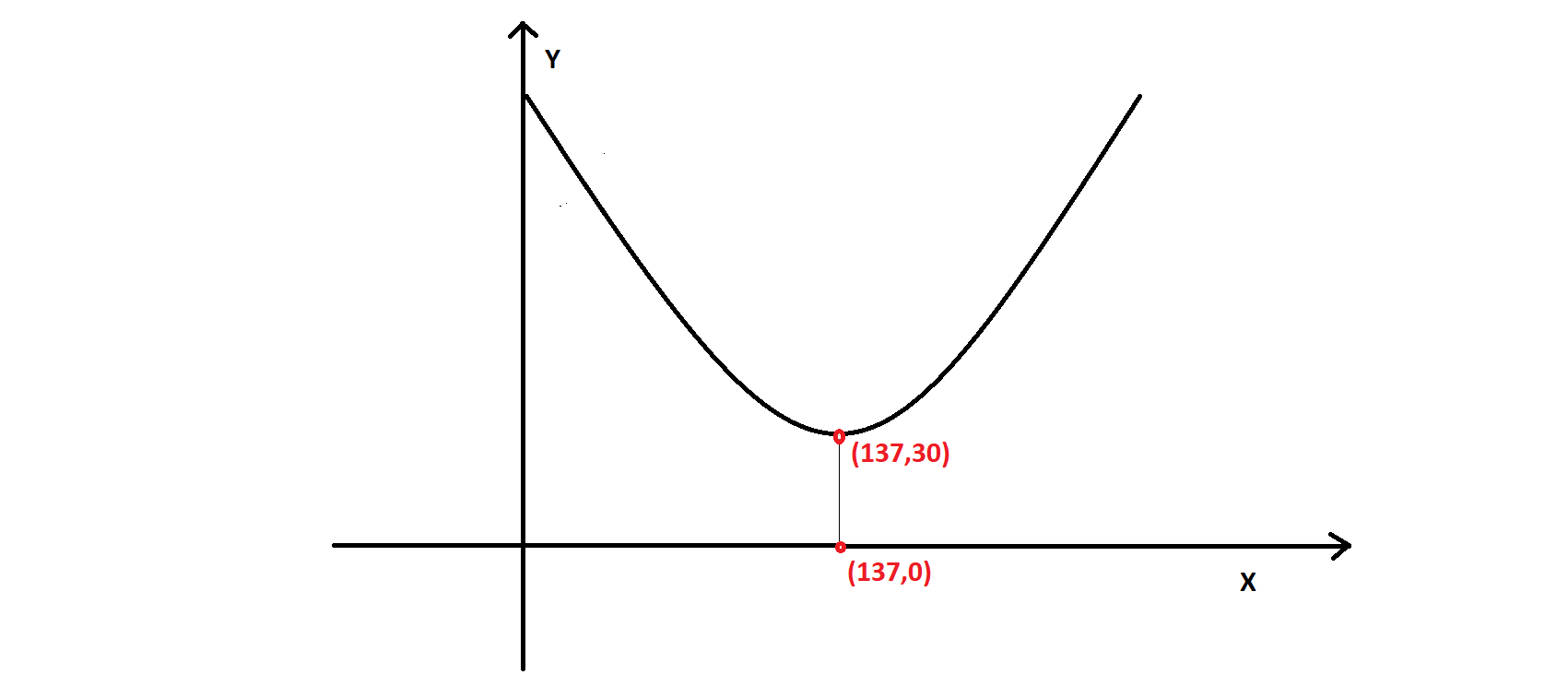
Hence, for this condition we have (p,q)=(137,30). So, the equation of the parabola will be
y=a(x−p)2+q
⇒y=a(x−137)2+30
⇒y=a(x2−2.x.137+18,769)+30
⇒y=ax2−274ax+18,769a+30
The equation of the shape of the cable when the origin is at
(1) When the origin is at the minimum point of the cable: y=ax2
(1) a point on the water’s surface directly below the minimum point of the cables: y=ax2+30
(3) When the origin is at the base of the tower on the left: y=ax2−274ax+18,769a+30
Mcgraw Hill Precalculus Textbook Answers
Page 199 Problem 14 Answer
Given: The distance between the towers is 274m.

Towers at a height of 52m above the surface of the water, and the lowest point of the cables is 30m above the water’s surface.
We have to explain Would the quadratic function change over the course of the year as the seasons change.
The shape is in Parabolic in nature, which is in the form of ax2+bx+c=0
So, The function will change as the seasons change with the heat or cold changing the length of the cable and therefore the function.
Hence, The function will change as the seasons change with the heat or cold changing the length of the cable and therefore the function respectively.
Page 199 Problem 15 Answer
We have given that :- The flea jumps 30cm high from the ground and 15cm away from his starting point.
The point from the flea is jumped is the origin.
We have to determine the quadratic function in vertex form to model the height of the flea compared to the horizontal distance traveled.
We will apply the formula of quadratic function in vertex form.
Here we have the the flea fly at the height 30cm and 15cm long horizontally from the starting point. The starting point is origin.
So the graph of his fly is as following :-
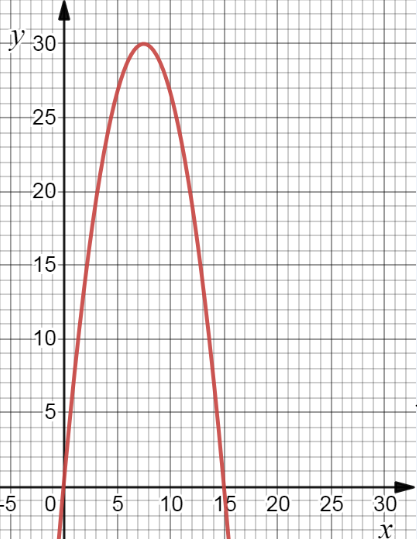
We can see that the vertex of the graph is (p,q)=(15/2,30)
Using the vertex form of parabola y=a(x−p)2+q, then we have :-
y=a(x−15/2)2+30
As (0,0) is the point of parabola. So it satisfies the above equation, then we have :-
0=a(0−15/2)2+30⇒0
=a(225/4)+30⇒225/4
a=−30
⇒a=−30⋅4/225
⇒a=−8/15
Put this value of a=−8/15, then we have :-
y=−8/15(x−15/2)2+30
⇒y=−0.534(x−7.5)2+30
This is the required quadratic function in vertex form.
The required quadratic function in the vertex form is :- y=−0.534(x−7.5)2+30
Mcgraw Hill Precalculus Textbook Answers
Page 199 Problem 16 Answer
The given graph of parabola is as following :-

We have to find the vertex, axis of symmetry, maximum or minimum value, direction of opening, domain and range and any intercepts.
The given graph is :-
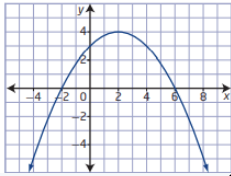
We can see that the curve changes its shape at point (2,4).
So the vertex of the graph is (p,q)=(2,4).
The graph is symmetric about the line x=2.
So the axis of symmetry is x=2.
The maximum value of the function is y=4 at x=2.
Also the function has no minimum value.
As the graph of parabola is closed from top and open from bottom.
So the graph is opens downward.
There exists a value of y for all values of x.
So the domain of the function is {x∣x∈R}.
As the graph is exist for all y≤4.
So the range of the function is {y∣y≤4,y∈R}.
As the graph cuts the x-axis at points x=−2,6.
So the x-intercepts are (−2,0) and (6,0) .
Also the graph cuts the y-axis at point y=3.
So the y-intercept is (0,3).
The required observations for the given graph are :-
The vertex of the graph is (2,4).
The axis of symmetry is x=2.
The maximum value of the function is y=4.
The graph is opens downward.
The domain of the function is {x∣x∈R].
The range of the function is {y∣y≤4,y∈R}.
The x-intercepts are (−2,0) and (6,0).
The y-intercept is (0,3).
Page 199 Problem 17 Answer
Given:
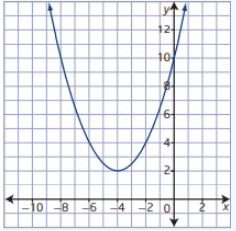
To identify the vertex, axis of symmetry, maximum or minimum value, direction of opening, domain and range, and any intercepts:
Use the definition of the upward parabola and find all the values based on this.
We have,

The vertex is lowest point on the graph which is(−4,2).
Axis of symmetry is the vertical line goes through the vertex and dividing the parabola into two equal parts.
So, we have x=−4.
For maximum and minimum value:
This is depend on the y−coordinate of the vertex.
If a>0 the vertex is the lowest point on the graph so the graph has a minimum value k.
Ifa<0, the vertex is the highest point on the graph so the graph has a maximum value k.
Here, 2>0
So, the graph has minimum value which is 2.
We knowa>0
So, the graphs open upwards.
Domain of the graph is(−∞,∞) and the range is[2,∞).
x−intercept: None
y−intercept:(0,10).
Hence, the values are Vertex: (−4,2)
Axis of symmter y:x=−4
Minimum value:y=2
Direction of opening: Upward
Domain:(−∞,∞)
Range:[2,∞)
x−intercept: None
y−intercept: (0,10)
Mcgraw Hill Precalculus Textbook Answers
Page 199 Problem 18 Answer
Given: y=7(x+3)2−41
To show why the given function fits the definition of a quadratic function:
Write the given function as ax2+bx+c.
Given:
y=7(x+3)2−41
Apply the formula(x+y)2=x2+y2+2ab
y=7(x2+32+2⋅x⋅3)−41
y=7(x2+9+6x)−41
y=7x2+63+42x−41
y=7x2+42x+22
Here, we can see that the equation is written in the form of y=ax2+bx+c.
Hence, it fits into the quadratic equation.
Hence, it has been showing that the given function fits the definition of a quadratic function.
Page 199 Problem 19 Answer
Given: y=(2x+7)(10−3x)
To show why the given function fits the definition of a quadratic function:
Write the given function asax2+bx+c.
We have, y=(2x+7)(10−3x)
Apply FOIL method:(a+b)(c+d)=ac+ad+bc+bd
y=2x⋅10+2x⋅(−3x)+7⋅10+7⋅(−3x)
y=20x−6x2+70−21x
y=−6x2−x+70
Here, we can see that the equation is written in the form of y=ax2+bx+c.
Hence, it fits into the quadratic equation.
Hence, it has been showing that the given function fits the definition of a quadratic function.
Page 199 Problem 20 Answer
Given: f(x)=−2x2+3x+5
To draw the graph of the function:
Use the graphing calculator to draw the graph of the function.
We have,
f(x)=−2x2+3x+5
Draw the graph:

Now, find the vertex
The parabola parameters are:
a=−2,b=3,c=5
xv=−b/2a
xv=−3/2(−2)
xv=3/4
Plug the value of xv in the given function:
yv=−2(3/4)2+3(3/4)+5
yv=49/8
Therefore the parabola vertex is (3/4,49/8)
Ifa<0, then the vertex is the maximum value.
So, the maximum value is y=49/8.
The Axis of symmetry is the vertical line that goes through the vertex and divides the parabola into two equal parts.
So, we have x=3/4.
We knowa<0.
So, the graphs open downwards.
The domain of the graph is(−∞,∞)
and the range is(−∞,49/8].
x−intercepts:(−1,0),(2.5,0)
y−intercept:(0,5)
Hence, the graph of the parabola is

Vertex:(3/4,49/8)
Axis of symmetry:x=3/4
Maximum value:y=49/8
Direction of opening: Downward
Domain:(−∞,∞)
Range:(−∞,49/8]
x−intercepts:(−1,0),(5/2,0)
y−intercept:(0,5)
Mcgraw Hill Precalculus Textbook Answers
Page 199 Problem 21 Answer
Given: f(x)=−2x2+3x+5
To explain the features of the graph:
First, draw the graph by graphing calculator then use the graph definition of the upward parabola to find the features.
We have, f(x)=−2x2+3x+5
Graph of the parabola:
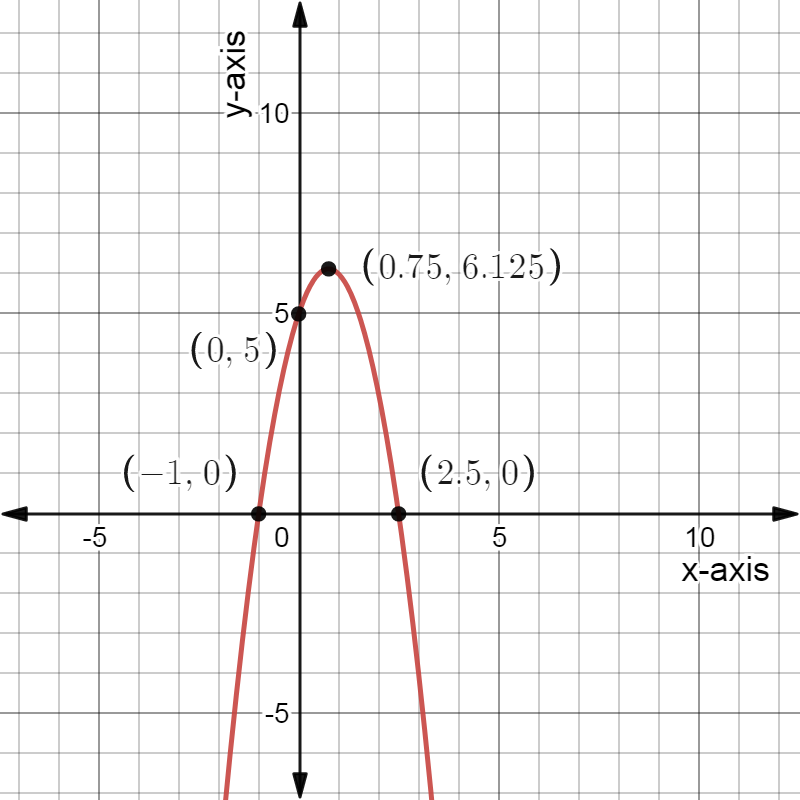
Vertex: The vertex of an up-down facing parabola of the form y=ax2+bx+c is(xv,yv)
where xv=−b/2a
So, we will compare the given function y=ax2+bx+c to finda,b, and c. Plug these values in−b/2a.
The axis of symmetry is x=h is the equation of the vertical line through the vertex.
The direction of the opening depends on a.
If a>0 graph upward and a<0 graph downward.
For maximum and minimum value: This depends on they−coordinate of the vertex.
Ifa>0 the vertex is the lowest point on the graph so the graph has a minimum value k.
Ifa<0, the vertex is the highest point on the graph so the graph has a maximum valuek.
The domain of the parabola is always(−∞,∞). and the range depends on the y−coordinate,k,
of the vertex and the orientation of the parabola.
x−intercept is the point wherey=0.
y−intercept is the point wherex=0.
Hence, the vertex of an up-down facing parabola is(xv,yv).
The axis of symmetry is x=h is the equation of the vertical line through the vertex.
The direction of the opening depends on a.
For the maximum or minimum value, this depends on they−coordinate of the vertex.
The domain of the parabola is always(−∞,∞) and the range depends on they−coordinate of the vertex.
x−intercept is the point where y=0. y−intercept is the point where x=0.
